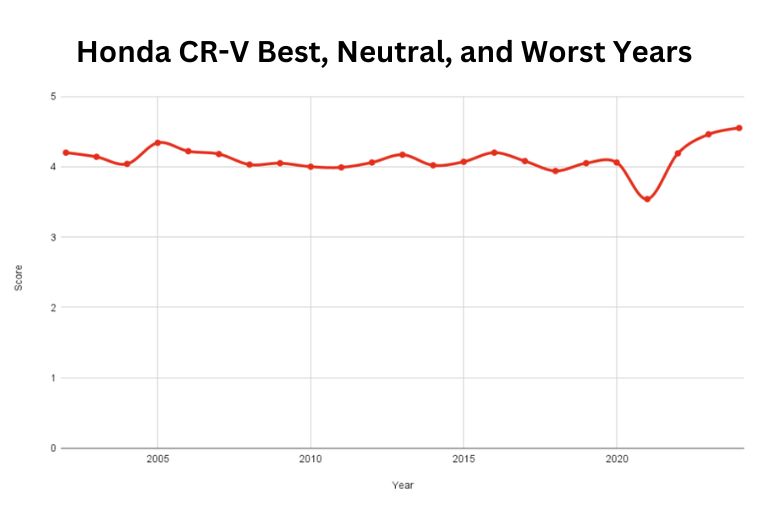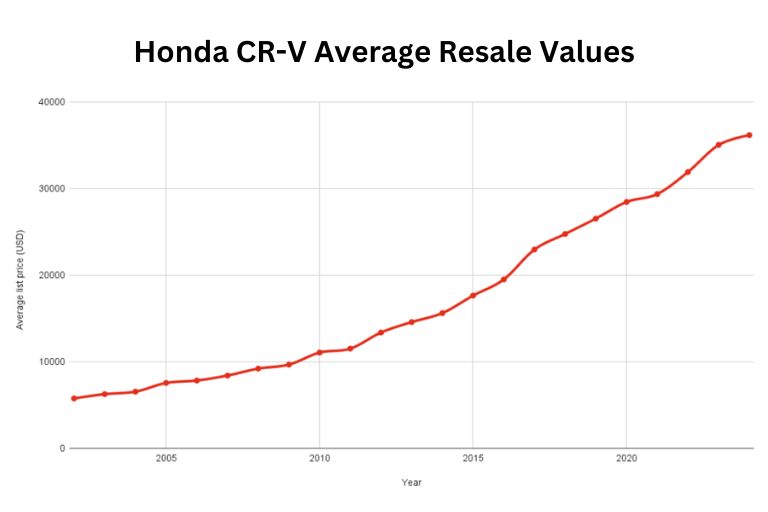The Honda CR-V has long been a favorite among SUV enthusiasts for its reliability, versatility, and comfort. But as with any vehicle, not all model years are created equal. we delve into the world of the Honda CR-V to uncover the best and worst Honda CR-V years of this popular crossover.
You’re in the market for a used CR-V or simply curious about how different model years stack up against each other, this comprehensive guide will provide valuable insights to help you make an informed decision.
We explore what sets certain years apart from the rest and reveal which ones truly stand out as the cream of the crop in the world of Honda CR-Vs.
You can also read:-
Best and Worst Honda Passport Years
Best and Worst Honda Element Years
Best and Worst Honda CR-V Years of Generations
The Honda CR-V has solidified its place as a top contender in the world of compact crossover SUVs since its debut in 1995. With each generation bringing new features and improvements, enthusiasts and everyday drivers alike have debated endlessly about which years truly stand out as the best for this beloved vehicle.
below is a breakdown of the Honda CR-V’s generations starting from 2002:
| Generations | Years |
|---|---|
| 2nd generation (RD4-RD9) | 2002-2006 |
| 3rd generation (RE1-RE5, RE7) | 2007-2011 |
| 4th generation (RM1-RM4, RE5-RE6) | 2012-2016 |
| 5th generation (RW1-RW8, RT5-RT6) | 2017-2022 |
| 6th generation (RS) | 2023-Present |
Its humble beginnings to the innovative advancements seen in recent models, exploring the evolution of the Honda CR-V through its various generations not only showcases impressive engineering but also provides valuable insight into what makes this car a perennial favorite on the roads.
Honda CR-V Best, Neutral, and Worst Years
The Honda CR-V has undergone several redesigns over the years, with some models standing out more than others. The 2015 Honda CR-V is often touted as one of the best years due to its spacious interior, fuel efficiency, and reliable performance. With a smooth ride and excellent safety ratings, this model continues to be a favorite among CR-V enthusiasts.

The 2002 Honda CR-V is considered a more neutral year. While it offers decent reliability and practicality, it falls short in terms of engine power and outdated features compared to newer models.For those seeking a budget-friendly option with solid performance, the 2002 CR-V remains a viable choice.
Best and Worst Honda CR-V Years of 2nd Generation (2002-2006)
The second generation Honda CR-V, spanning from 2002 to 2006, has seen its fair share of highs and lows. Many enthusiasts consider the 2005 model year as one of the best for the CR-V due to its refined engine performance and enhanced safety features.
The sleek design coupled with a reliable drivetrain made it a popular choice among consumers looking for a versatile SUV.

The 2002 model year faced criticism for its subpar fuel efficiency and lackluster interior quality compared to later models in the lineup. Despite being a solid performer in terms of handling and off-road capabilities.
Some buyers found the initial offering somewhat underwhelming in terms of overall comfort and technology features. As Honda continued to improve upon the CR-V platform throughout this generation, subsequent years saw significant upgrades that addressed these early shortcomings.
The Best Years: 2005, 2006
In the automotive world, the years 2005 and 2006 stand out as a golden era for the Honda CR-V. These models were celebrated for their solid build quality, reliable performance, and sleek design that captivated both new buyers and loyal fans.
The CR-V’s versatility was unmatched during this time, seamlessly adapting to various road conditions and providing a comfortable ride for drivers and passengers alike.
What truly set the 2005 and 2006 Honda CR-V apart was its innovative technology features that were ahead of its time. From advanced safety systems to state-of-the-art entertainment options, these models offered a driving experience that felt both luxurious and practical.
The success of the Honda CR-V during these years paved the way for future advancements in SUV design, making it a timeless classic in the hearts of car enthusiasts worldwide.
The Worst Years: 2002, 2003, 2004
The years 2002, 2003, and 2004 were certainly difficult for Honda CRV enthusiasts. Despite being a popular SUV choice in the early 2000s, these particular models faced some significant quality issues that tarnished the reputation of the brand.
Owners reported problems with transmission failures, engine troubles, and various other malfunctions that made maintaining these vehicles a costly affair.
The challenges faced during these years pushed the company to improve their quality control measures and implement more rigorous testing protocols. As a result, subsequent models saw significant upgrades and refinements that helped restore confidence in the brand among consumers.
This turbulent time ultimately paved the way for Honda to bounce back stronger than ever in the following years.
Best and Worst Honda CR-V Years of 3rd Generation (2007-2011)
The Honda CR-V 3rd generation, spanning from 2007 to 2011, has been a mixed bag in terms of reliability and performance. Among the standout years, the 2008 model shines brightly for its winning combination of spacious interior, fuel efficiency, and solid build quality.
This year marked a peak in consumer satisfaction due to its smooth handling and overall durability. Contrary to expectations, the 2010 CR-V emerges as one of the worst years in this generation due to reported issues with excessive oil consumption and failing door lock actuators.
These setbacks tainted an otherwise reputable lineup within the CR-V series.

The 2009 Honda CR-V stands out as a surprisingly consistent performer with minimal reported problems. It was well-regarded for its comfortable ride quality and practicality, making it an appealing choice for many buyers looking for a reliable compact SUV during that time period.
Despite facing tougher competition in later years, such as advancements in technology and design aesthetics from other automakers like Toyota and Ford, loyal fans of the CR-V still hold these model years with high esteem.
Overall, when considering a purchase within this timeframe, careful research and inspection are essential before committing to ensure you’re getting the best value for your investment.
The Best Year: 2009
In 2009, the Honda CRV experienced one of its best years on record. With improved safety features and a sleek redesign, the CRV captured the hearts of consumers seeking reliability and style in their SUVs.
The introduction of advanced technology like Bluetooth connectivity and a rearview camera set the 2009 model apart from its competitors, making it a standout choice for many drivers.
This commitment was clearly reflected in the CRV’s performance that year, with an impressive boost in miles per gallon that appealed to eco-conscious consumers.
The increased emphasis on sustainability not only made the 2009 Honda CRV a top choice for car buyers but also positioned Honda as a leader in creating efficient and environmentally friendly vehicles ahead of its time.
The Neutral Years: 2010, 2011
The Neutral Years of 2010 and 2011 marked a period of stability and fine-tuning for the Honda CR-V, a crossover SUV that was already gaining popularity. These years saw Honda focusing on refining the CR-V’s design, technology, and performance rather than introducing groundbreaking changes.
While some enthusiasts may have found this period lacking in excitement, it was during these years that the CR-V solidified its reputation as a reliable and practical vehicle.
Despite not being known as the most innovative years for the Honda CR-V, 2010 and 2011 are widely regarded as some of the best in terms of overall quality and value for this model. The understated upgrades made during this time helped to enhance the driving experience without compromising on what made the CR-V such a beloved choice for families and individuals alike.
These neutral years laid the foundation for future success by setting a benchmark in terms of reliability and practicality that would continue to define the Honda CR-V in the years to come.
H3: The Worst Years: 2007, 2008
The years 2007 and 2008 were particularly challenging for the automotive industry with the onset of the global financial crisis. Honda’s CRV, known for its reliability and spacious interior, faced declining sales during this tumultuous period. Customers were hesitant to make big purchases, leading to a significant drop in CRV sales during these years.
The economic downturn also affected consumer preferences, with fewer people opting for larger vehicles like SUVs. Honda struggled to navigate through these turbulent times, causing a temporary setback for the popular CRV model.
Despite the challenges faced in 2007 and 2008, Honda managed to weather the storm and regain momentum in subsequent years by adapting its strategies to meet evolving market demands.
Best and Worst Honda CR-V Years of 4th Generation (2012-2016)
The 4th generation Honda CR-V, spanning from 2012 to 2016, showcased both highs and lows in its lineup. Among the standout years, 2015 emerges as a top choice for enthusiasts due to its refined interior, ample cargo space, and improved fuel efficiency.hTe addition of advanced safety features made this year an attractive option for those prioritizing passenger protection.

On the flip side, 2012 stands out as one of the more challenging years for the Honda CR-V due to reported issues with excessive oil consumption in some models. While this setback didn’t affect all vehicles within this year range, it’s worth noting for potential buyers looking into used options from this specific production year.
Despite this hiccup, subsequent model years within the 4th generation offered notable improvements that addressed such concerns and provided consumers with a reliable choice in the compact SUV segment.
The Best Years: 2013, 2016
In 2013, the automotive world witnessed the launch of the Honda CR-V 4th Generation, a true game-changer in the SUV market. With its sleek design and advanced features, this vehicle set a new standard for luxury and performance.
The CR-V’s spacious interior and smooth ride made it a top choice for families and adventure seekers alike. In 2016, Honda continued to dominate with upgrades to the CR-V, enhancing its fuel efficiency and safety features. This model became a favorite among consumers looking for reliability and style in their everyday drives.
The years 2013 and 2016 mark significant milestones for Honda enthusiasts who can attest to the groundbreaking improvements made in each generation of the CR-V. The blend of innovation and practicality showcased by these vehicles transformed how people experience driving on both urban streets and rough terrains.
As technology continued to advance during this period, Honda stood out as a frontrunner in creating cars that catered to evolving consumer needs while retaining their signature quality craftsmanship. The success of the Honda CR-V during these years solidified its reputation as an industry leader that prioritizes both comfort and performance.
The Neutral Year: 2012
In 2012, car enthusiasts were buzzing with excitement as Honda unveiled the much-anticipated 4th generation CR-V. Boasting a sleek design and upgraded features, the CR-V set a new standard in the compact SUV market.
Its spacious interior and fuel-efficient engine captured the hearts of many drivers seeking both style and practicality.
The automotive industry witnessed a shift towards sustainability in 2012, with hybrid and electric vehicles gaining popularity. As environmental awareness grew among consumers, automakers like Honda responded by introducing eco-friendly models like the CR-Z and Insight.
This marked a pivotal moment in the industry’s focus on reducing carbon emissions and promoting greener transportation options.
The Worst Years: 2014, 2015
In the automotive realm, the years 2014 and 2015 marked a turbulent phase for Honda with the launch of its fourth-generation CR-V. Despite holding a strong position in the compact SUV segment, these particular model years faced criticism for lacking innovation and falling behind competitors in terms of design and technology.
The industry was abuzz with discussions revolving around Honda’s apparent stagnation and failure to keep up with evolving consumer demands.
Detractors pointed out that while the CR-V continued to offer reliable performance and practicality, it failed to deliver the level of excitement and modern features that were becoming increasingly common among rival models.
This highlighted a crucial point about the evolving landscape of automotive design where mere reliability was no longer sufficient to capture buyers’ attention. The lukewarm reception towards Honda’s flagship SUV during this period underscored a critical need for manufacturers to prioritize innovation and stay attuned to changing market dynamics or risk being left behind in an ever-evolving industry.
Best and Worst Honda CR-V Years of 5th Generation (2017-2022)
The 5th generation Honda CR-V, spanning from 2017 to 2022, has showcased both highs and lows in its journey. The year 2017 stands out as one of the best for the CR-V, introducing a sleek redesign and a more upscale interior. This year marked a significant leap forward in terms of style and technology for the popular crossover SUV.

2020 proved to be one of the most challenging years for the CR-V, with numerous complaints about engine issues such as oil dilution problems affecting performance. Despite its reputation for reliability, this setback highlighted some quality control concerns that Honda had to address promptly to maintain customer trust.
Overall, while certain years have shone brighter than others for the Honda CR-V 5th generation, it’s essential to weigh both the achievements and challenges in evaluating its performance over time.
The Best Years: 2022
The automotive industry is abuzz with anticipation for the 5th generation Honda CR-V. Set to be released in 2022, this iconic model promises to revolutionize the SUV market with its cutting-edge technology and sleek design.
From intelligent safety features to a fuel-efficient engine, the new CR-V is set to redefine what it means to drive in style and comfort.
As we enter 2022, it’s clear that these will be the best years yet for car enthusiasts. With advancements like electric vehicles gaining popularity and self-driving technology becoming more accessible, drivers can expect a whole new experience on the road.
The 5th generation Honda CR-V is just one example of how automakers are pushing boundaries and setting new standards for innovation in the industry.
The Neutral Years: 2019, 2020
During the neutral years of 2019 and 2020, the automotive industry saw a remarkable shift towards sleeker and more tech-savvy vehicles. Among these innovations was the introduction of the fifth generation Honda CR-V, which exemplified a perfect blend of style, comfort, and performance.
With its spacious interior and advanced safety features, this SUV quickly garnered popularity among consumers seeking both practicality and luxury in their daily commute.One standout aspect of the Honda CR-V 5th Generation was its impressive fuel efficiency that resonated well with eco-conscious individuals looking to reduce their carbon footprint without compromising on power.
The sleek design of this model not only enhanced its aerodynamics but also gave it a modern edge that appealed to those seeking a vehicle that seamlessly transitioned from city streets to open roads.
As we reflect on these neutral years, it is clear that the Honda CR-V set a new standard for crossover SUVs by offering versatility combined with cutting-edge technology – truly defining an era where neutrality met innovation in perfect harmony.
The Worst Years: 2017, 2018, 2021
The years 2017, 2018, and 2021 were tumultuous for Honda CR-V fans as the fifth generation faced several challenges. In 2017, the model suffered from engine oil dilution issues that left many owners frustrated and worried about their vehicle’s longevity.
The following year, in 2018, a widespread fuel leak recall further tarnished the reputation of this once-beloved SUV.
Fast forward to 2021, and CR-V enthusiasts were hit with an unexpected blow when supply chain disruptions led to production delays and shortages of essential parts. This trifecta of setbacks tested the loyalty of even the most dedicated Honda aficionados and highlighted the need for better quality control measures in future models.
Despite these challenging years, loyal fans continue to stand by their beloved CR-Vs, hopeful for a brighter future with improved performance and reliability.
Best and Worst Honda CR-V Years of 6th Generation (2023-Present)
The 6th generation Honda CR-V (2023-Present) has truly raised the bar for compact SUVs with its sleek design and impressive performance capabilities. With a focus on both style and functionality, this latest iteration of the CR-V seamlessly blends modern aesthetics with practical features to cater to the diverse needs of drivers.

The spacious interior ensures a comfortable driving experience, while advanced technology integrations elevate convenience and safety behind the wheel.One standout feature of the Honda CR-V 6th generation is its responsive handling, making it a joy to drive on various terrains.
The improved fuel efficiency further enhances its appeal as an eco-friendly choice in the competitive SUV market segment. Whether cruising through city streets or embarking on a weekend adventure, this versatile vehicle offers a harmonious balance between power and efficiency, making it a standout option for those seeking a reliable and stylish ride.
Honda CR-V Average Resale Values
The Honda CR-V has long been known for its strong resale value in the automotive market. With its reputation for reliability, practicality, and comfort, the CR-V consistently holds its value well over time. Despite being a popular choice among buyers, the high demand for used CR-Vs helps to maintain their resale values.

One interesting trend to note is that newer models of the Honda CR-V tend to hold their value better than older models. This could be attributed to technological advancements and improvements in safety features that make newer CR-Vs more appealing to potential buyers.
Factors such as mileage, condition, and market trends can also influence the average resale value of a Honda CR-V.
The combination of Honda’s reputation for quality and the enduring popularity of the CR-V make it a standout choice for those looking to maximize their investment in a reliable crossover SUV.
Conclusion
The Honda CR-V has had its highs and lows over the years, with certain model years standing out as the best and worst options for buyers. While some years have been praised for their reliability, safety features, and overall performance, others have faced criticism for various issues such as engine problems or lackluster technology.
It is important for potential buyers to carefully research and consider the specific model year they are interested in to ensure they make an informed decision. By weighing the pros and cons of each year, consumers can select a Honda CR-V that meets their needs and preferences. So before making a purchase, take the time to compare different model years and find the one that suits you best.
FAQ
Q: What are some common issues with the 2014 Honda CR-V?
A: The 2014 Honda CR-V is known for potential air conditioning and power steering problems.
Q: Is the 2017 Honda CR-V a reliable choice?
A: Yes, the 2017 Honda CR-V is highly rated for its reliability and performance.
Q: Are there any safety concerns with the 2018 Honda CR-V?
A: The 2018 Honda CR-V had some reports of engine oil dilution issues affecting fuel efficiency.
Q: Which year of the Honda CR-V has the most spacious interior?
A: The 2020 Honda CR-V offers one of the most spacious interiors compared to other years.
Q: What makes the 2007 Honda CR-V stand out from other model years?
A: The 2007 Honda CR-V is praised for its excellent fuel economy and overall durability.

